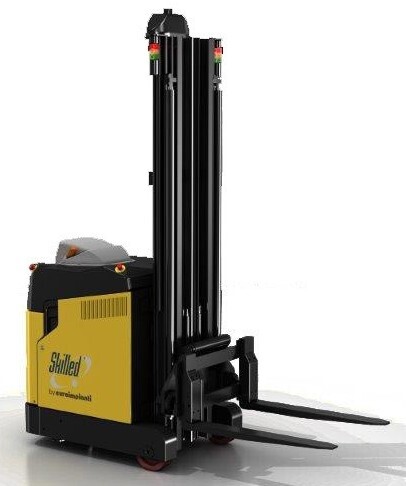Anytime I hear “labour shortage” I remember what it really means is not enough people willing or able to work slave wages.
Japanese unemployment rate seems to be around 2,6%. They might genuinely lack truck certified people, especially depending on how many of that % is short term unemployed and whatnot
Removed by mod
Who do that if robots work though
If you overhaul society so that it doesn’t end up being just the uberwealthy earning even more profits while even less entry level jobs are available to most of the population.
I don’t get it. Does immigration have some advantage to robots in this case?
Then pay to train people and ensure them a stable job. Offer a sweet deal, as workers are supposed to be agents who work in their self interest. The capitalism the right uses to argue for freer markets should demand this, but when capitalists get angry about labor shortages and act like they simply deserve loyal workers, it shows that they never gave a shit about liberal ideals. They only want to fuel their greed and fucked up desires to own other human beings as much as they can.
You mean to switch a job? Because we don’t know if those unemployed people are just temporarily between jobs, alkies, shut-in neets or what. Just paying to train them might not be a silver bullet, could just mean some other field will now face the employee shortage
And then the, “free market,” will decide what’s important based on how necessary it is for society. It will drive innovation to get more efficiency from workers, while disincentivizing poor conditions that would cause employees to jump ship for better work.
Besides, forklift operators are less necessary for society to function than something like doctors or nurses. While the free market can adjust for forklifts by training operators and decreasing the volume of non necessity sales the forklifts handle, lack of healthcare workers leads to far more death and suffering. That destabilizes society and hurts productivity in serious ways.
It’s actually in the best interests of the wealthy to ensure services like healthcare are affordable and that those workers are paid well. Not only could them or their loved ones experience medical emergencies where their wealth can’t be leveraged fast enough, but their workers will be less productive than those in countries with good healthcare, who will eventually out compete them.
The delusion of the rich and powerful is that they believe it’s possible to win at the game of exploitation and cruelty in the modern era. Some fail to grasp that people will always be dangerous when you make them miserable, attacking whatever they think is the threat. Some elites recognize the danger of unhappy people, using tribalism and hate for others to redirect the anger. However, this leads to war internally and externally, and modern war is worse than war of the past. It’s easy to destroy, and hard to prevent destruction. The costs of war are massive, and exploitation of other humans is the fuel for all human conflict. Good faith deals that benefit everyone are the best way to prevent violence in a closed system like earth.
If an apple costs a dollar and you don’t wanna pay that, there isn’t an apple shortage. The apples are there.
Gonna be so funny when management goes into the warehouse themselves to clean up a collapsed product storage rack.
Let’s see where culpability lands after the first lawsuit, then I’ll decide if my forklift certification is in danger.
Also lol @ OSHA (is it even OSHA, or state level?) forklift certification courses, it’s so easy if you have any functioning memory you’ll pass the written, and the practical is a bigger joke.
If you need a refresher, this video has you covered (German with English subtitles, CW: Gore).
Absolute legendary clip
deleted by creator
When I did it I got to a question I didn’t know and I jokingly asked the instructor what the answer was and he said “I can’t give you the answers” and then after a short pause “but there isn’t a rule about you all talking amoung yourselves”
In the three places I worked with lift equipment, one had no training, one had a week long course, and one relied on “previous experience” until they could squeeze you in to the one day class they periodically held for the revolving door of workers.
Automated forklifts have existed for quite a while, though they’re in fully automated facilities and there’s no risk of running over humans. I’ve worked at 2 different companies working on autonomous forklifts that are intended to be safe around humans and I don’t think they’ll really be able to compete on a large scale with humans anytime soon. Humans are so much faster. There are some environments where autonomous forklifts exceed, like warehouses that store hazardous materials, warehouses that contain products that get routinely stolen by employees, etc.
What kind of products are in those warehouses that employees kept stealing?
Mostly phones, but also bluetooth speakers, headphones, and other small & valuable electronics.
They don’t need fully automated areas, we have a couple dozen JBT AGV’s at work. They are fitted with 3 extra sensors, but it is my understanding those aren’t strictly required for them to operate in aisles shared with drivers and pedestrians; more of an abundance of caution choice. While they are slower, they must be well worth it since more are added every year.
I don’t understand, haven’t these robots existed for almost 20 years? We’ve got a half dozen of these where I work moving pallets of stuff around the warehouse.

Because forklift operators operate where there are humans around and a single fuckup can mean a bloody and violent death, and with it huge penalties for procedures not being followed.
It is understandable to not want to essentially put your entire company at risk to roboticise a few jobs.
So, roboticise them all! It is much more real today to have robot-only warehouses.
Yeah, the problem with that is machines fuck up. So do humans, but unlike machines, humans can recognise when they’ve fucked up, and do something about it. Humans can use common sense and react accordingly, but robots won’t do shit outside of their programming.
Also, the machines themselves get fucked up, especially the mechanical moving parts. You can have a human tech on site, but if the malfunction prevents the robot from moving, that techie has to go out into a warehouse full of machines going at ludicrous speeds with no way to see them. They can shut the warehouse down temporarily, but do that often enough and you’ll completely negate any benefits to having almost-all automaton workers very soon.
Seems easy enough to me to have a 6-8 hour “human shift” where the bots are shut down for maintenance, and then run the bots the rest of the 24 hour cycle. If something mucks up (and there can and will be sensors to determine this) you suspend that section of production until humans can come unfuck it, maximum one day of downtime for a given area unless major overhauls are required. Your efficiency would still be off the charts compared to a human staffed warehouse even accounting for daily maintenance shifts and semi frequent interruptions.
Seems easy enough to me to have a 6-8 hour “human shift” where the bots are shut down for maintenance, and then run the bots the rest of the 24 hour cycle.
Checkups only reduce the likelihood of something going wrong, not eliminate it completely. You would still have times where you gotta shut everything down to work on the robots.
If something mucks up (and there can and will be sensors to determine this)
Sensors themselves can go wrong. While you can absolutely have some fail safes, one of the problems about these things working in the real world is that nothing is a simple binary solution, and failures can look like something that just won’t plain show up in software.
What do I mean? Let’s create an example. Robot A has moved very close to Shelf A while looking for a given object. The robot sees it on Shelf B, just behind shelf A, because the part of Shelf A the robot is at is empty. However, the robot is so close to the shelf and the camera is positioned in such a way that it cannot see Shelf A, It believes it has a direct path to Shelf B. So what does it do? It plows forward directly into Shelf A, destroying the entire shelfing unit and destroying hundreds of thousands worth of merch.
Think this is far fetched? Teslas have caused crashes and killed people by this same flaw.
If something mucks up (and there can and will be sensors to determine this) you suspend that section of production until humans can come unfuck it, maximum one day of downtime for a given area unless major overhauls are required.
The problem is that this doesn’t scale well. What do I mean? Let’s say that the chance of a mobility breakdown requiring a total warehouse shutdown in order to safely fix in a year is 1%. Keep in mind this is very optimistic.
This works well enough for 1 robot in the warehouse. You get max 3.65 days of downtime from this little trooper. However, unless this warehouse is basically someone’s shed, this isn’t a realistic number. A decently sized warehouse is going to have something like 40 or 50 of these things and distribution centers? They’ll have hundreds. That means your facility downtime goes from a few days to entire chunks of the year.
Sure, with larger facilities, you could isolate given areas, but you can’t just get away with isolating one shelf or one area, you have to create a safe path for technicians to get there. That potentially means shutting down areas that weren’t affected simply because they’re the only or main way through.
And god help you if an attacker gets on your network. The typical security around these kinds of devices is comically shit. They basically rely on an attacker not getting onto the same network as the devices, something a physical Intrusion will get around pretty darn easy.
Oh no, now what are people going to shriek any time someone mentions college?
What am I gonna do with my certificate now?
fight for better pay/compensation instead of against innovation
Sounds like you should unionize about it










